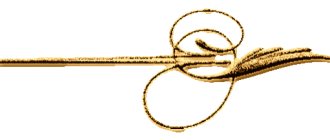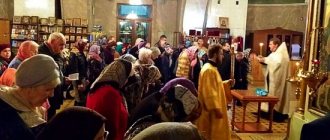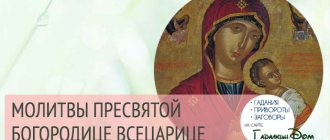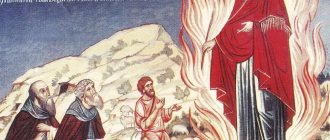History of prayer and image
The end of the 19th century in Russia turned out to be a lean harvest, drought led to hunger and despair. Prayers to God for help were heard from all homes, churches and temples. The Monk Ambrose, an elder of the Optina Hermitage, in 1889 gave his blessing to paint an icon of the Mother of God to which everyone would pray for the harvest. A year later, Ambrose had the icon. He gave her the name “Spreader of the Loaves” and declared October 15 (28 according to the new style) as a day of celebration. In front of the icon of the Mother of God, sitting in the clouds and holding her hands in a blessing gesture, they began to read the prayer “Spreader of the Loaves.”
In the image, the Mother of God looks from heaven onto a field where the harvest is gathered into sheaves. This idea belongs to Ambrose of Optina himself, but the image of the Mother of God was taken from the icon of “All Saints”. The icon was kept by the elder in his last years, which he devoted to the creation of the Shamordino monastery. There, in 1891, in all the fields in the district, an unprecedented harvest was harvested, which was enough for the next year, but in other parts of the country the famine continued. Copies from the icon were sent to churches so that others could read the prayer in front of the “Spreader of the Loaves” icon.
The world said goodbye to the Monk Ambrose in 1891, on a significant date for him, October 15. And although the icon created with his blessing does not have a centuries-old history, it became a helper to people. The prayer to the Most Holy Theotokos “Different of Loaves” is read for success in a variety of matters.
The icon “Spreader of the Loaves”: how it helps and how to pray
"Save me, God!". Thank you for visiting our website, before you start studying the information, please subscribe to our Orthodox community on Instagram, Lord, Save and Preserve † – https://www.instagram.com/spasi.gospodi/. The community has more than 60,000 subscribers.
There are many of us like-minded people and we are growing quickly, we post prayers, sayings of saints, prayer requests, and timely post useful information about holidays and Orthodox events. Subscribe. Guardian Angel to you!
In 1889, Elder Ambrose of Optina gave the blessing to Ilaria, the abbess of the Belevsky Monastery, to create for him an image of the Mother of God as an example of a completely new, non-traditional icon painting. Already in 1890, the abbess gave him a work by the church painter Hieromonk Daniel: in it, the All-Tsarina rises above the earth, sitting on a cloud. Behind her image one can see a sprawling grain field, and in the lower plan of the picture there are compressed spikelets collected into sheaves. The hands of the Mother of God raised to heaven froze in a gesture of blessing.
What do they pray to the Mother of God “Different of the Loaves”?
The history of the appearance of the icon of the Mother of God is connected with crops, so most often a prayer is read before her image for growing and harvesting a good harvest. They ask the Mother of God to protect the fields from the elements: frost, hail and downpours, drought and fires. They pray for blessings for grateful work in the field, support at the beginning of sowing and harvesting.
Nowadays people turn to the icon not only during field work. They read the prayer “Spreader of the Loaves” for trade and prosperity. They ask the Mother of God for help in difficult financial situations: poverty, debts. The Mother of God protects not only the soul, but also helps in worldly affairs, because bread, food, is necessary for life, and, therefore, is also important.
Among other things, older people turn to the Mother of God in prayer to find support and strength from her, and young people pray for success in business.
The meaning of the image of the Virgin Mary
This holy painting became Father Ambrose’s parting gift to the convent he created near the Optina Pustyn monastery in the Shamorda village of the Kaluga region of Russia. It is not surprising that the view of the grain field, which frames the icon of the Mother of God “Different of the Loaves” from below, was painted precisely from the landscape near the monastic refuge.
This face also received its name thanks to Hieromonk Optina. The very word “controversy” has two meanings: “to be filled” and “to help”—with this name of the icon the monk wanted to convey to people that the Lady of the world hears requests not only for the salvation of the soul from temptations and sins, but also for successful work on earth.
Icon of the Mother of God “Bread”
The Icon of the Mother of God “Bread” appeared to Saint Philip of Moscow while he was asceticizing in the Solovetsky monastery.
In the world, the boyar Feodor Kolychev, at the age of 30, he left public service and, in simple clothes, secretly retired to the Far North. Without revealing his name, he worked at general obediences as a simple monk. Soon the reverent novice was assigned to the bakery - making prosphora and bread for the fraternal meal. It was not easy for the noble boyar in this very difficult obedience, however, despite all the hardships, he did not give up prayer. The Mother of God, to Whom the monk Philip always resorted with special zeal, consoled the novice by revealing to him Her miraculous image. This happened in the 1540s. Philip placed the new icon of the Mother of God at the place of his obedience - near the baking oven, and from then on he had the habit of placing all the newly baked prosphora and breads in front of it, as if offering it to the Mother of God Herself. The brethren, coming for prosphora and bread, took them from the image, as if from the hands of the Most Pure One. The icon also began to be called “Baked” or “Bread”.
After the martyrdom of St. Philip in 1569 (January 22 N.S.), the image of the “Bread” Mother of God became one of the most revered in the Solovetsky monastery and became famous in many parts of Holy Rus'.
Where can you find the holy face of the Virgin Mary
In 1892, the Holy Synod ordered the removal of the original holy image from Shamordino. Subsequent events that happened to this icon were not recorded, so now its exact location is unknown. There are suggestions that the original is now kept in Lithuania in the village of Mikhnevo, near Vilnius. In the Shamordino monastery itself, which revived its service to the Lord in 1990, one of the newer traditional copies of the icon of the Mother of God is venerated.
Days of celebration of the icon “Spreader of the Loaves”
Exactly one year before his death, on October 15, 1890, Father Ambrose of Optina ordered the novice to write down her will that every year on October 15 according to the old style (October 28 - according to the new style) a service would be held at the Shamordino monastery, an akathist would be read and an akathist would be sung in praise Mother of God.
God bless you!
Watch also the video about the icon of the Mother of God “Different of the Loaves”:
Prayer of the Mother of God of Bread
Memory of the image September 21 (8)
Before the icon of the Mother of God “Khlebnaya” (“Khlevennaya”) they pray:
for the sending down of the daily stable,
to get rid of financial difficulties,
to help you save or find work,
to calm down and gain faith in the future.
In one northern village, the boy Filya was left an orphan. So he lived alone in the empty house he inherited from his parents. All summer he got by in some way - he would help one neighbor with the housework, then another in the garden, and everyone fed him a little.
But that village was poor, and when winter began, no one could feed the boy - in each family there were seven of their own in shops. Then the local priest took pity on him - he settled him in a closet at the church so that the boy would not freeze in his unheated hut, sat him down at the table with his family, and in the evenings taught him to read and sing prayers.
Philip turned out to be a smart boy, he quickly mastered reading and writing and began to ask his father for books, and he was glad - the lives of the saints and the teachings of the church fathers gave him everything.
And once a boy was reading about the Solovetsky monastery, and came to the life of St. Philip, Metropolitan of Moscow, to whom the miraculous image of the Most Holy Theotokos “Bread” was miraculously revealed. Then an inspiration came over him - he, too, was baptized by Philip. So this is his patron saint! The Mother of God herself noted him.
Then he began to ask the priest to show him this wonderful icon. And he didn’t have such an image. The boy was upset, but decided, as soon as the snow melted, to go to Solovki to see this image. But not even three days had passed before the icon itself found the boy. One frosty evening, three wanderers knocked on the door. The priest let them in - it turned out that they were walking along Russian land, worshiping Orthodox shrines. Now they are moving from the Solovetsky Monastery.
Then Philip began to ask them about the monastery, and about its shrines, and about the image of the “Bread” Mother of God. Then one of the wanderers reached into his bosom and pulled out a small list from that icon. The boy grabbed onto it with both hands - he couldn’t tear it off. Father began to make excuses:
“The boy’s name is Philip, but since he read about Philip of Moscow, now he only sleeps and sees how he can worship the image of this saint.
The wanderers looked at each other, and decided to leave the icon to the boy - to know if it had found its place. May the grace of the Mother of God and Saint Philip rest on the boy.
Every evening the boy prayed for a long time in front of the holy image, asking for help to be sent to him - the opportunity to go to the city to study. And more than once he dreamed that the Most Pure Mother of God herself was coming for him, taking him by the hand and leading him through a marvelous garden, among flowers and trees, unprecedented in their northern region.
And in the spring his fate was decided. The landowner who owned these lands was going to hunt in the vicinity of the village, and he took his friend, a southerner, with him to show him the northern nature.
The hunters were tired, but they turned into the priest’s house to rest and drink water. And they took a liking to the smart boy so much that they decided that it was no good for him to vegetate in the northern wilderness, they should take him to the city and train him to do some work.
At the master's house, Philip quickly became friends with the gardener, and began to adopt science surprisingly easily. The landowners noticed this, and when the guest began to get ready to go home, he took the boy with him to take care of the southern garden and the greenhouses.
When Philip first entered that garden, he immediately recognized those wonderful flowers among which the Mother of God had taken him in his dreams.
Based on materials from the folklore expedition of 1897.
In the sixties, I came from the village to Moscow to go to university. I entered, settled in a dormitory and began studying. Everything would be fine, but I had to live on one scholarship. My parents still had four younger brothers and sisters at home, and my grandmother was old, so they couldn’t help me with money.
During the semester I managed to somehow earn extra money, but when the exams started, I had no time for work. And if there is no work, there is no money, even if you put your teeth on the shelf.
I was lying down one night and couldn’t sleep, I was so hungry. And she began to remember the house, her parents, her grandmother... And then her story popped into her head about how they lived through the hungry years in the village - the whole parish prayed in front of the icon of Our Lady “Bread”. And what miracles happened through these prayers.
I think all I can do is pray. Only I didn’t know any prayers. And he began to ask the Mother of God to help me - not to let me die of hunger, to help me learn so that I could work, earn good money, help my father and mother. With such thoughts I fell asleep.
And in the morning I woke up - there was a piece of bread on the table. Yes, so strange - I’ve never seen anything like this in stores in our area. I also thought that maybe one of the neighbors had received a parcel from home and took pity on me - he brought a piece while I was sleeping.
I ate this piece, and it was quite small, I must say, but it’s amazing - I ate well, and didn’t feel hungry all day afterwards. It's a pity I didn't know who to thank for this.
And the next morning the piece appeared on the table again. When the week passed like this, I realized that it was not my comrades who were feeding me. And he began to ask the Mother of God to reveal to me who was sending me bread. And after that, in a dream, I saw the Mother of God herself, she was walking towards me and holding out pieces of bread - exactly as they appeared on my table every day. I began to thank the Mother of God for her help. And in the morning I wrote a letter home - I asked my grandmother to send me that old icon, “Bread”, so that it would be before my eyes all the time.
So I passed the test, and the morning came when I woke up and found no bread on the table. But when I came to the university, a surprise awaited me - the head of the department invited me to work as a laboratory assistant. And this meant a small but stable salary. Of course, I immediately agreed. This is how the Mother of God took care of me.
So many years have passed since then, I have long been a professor myself. And, I must say, I always try to help poor students, especially if they show obvious abilities - as if I am repaying a debt. And I still keep that icon with me.
Emelyan Nikolaevich, Moscow
PRAYERS BEFORE THE ICON
Only a small excerpt of the Never Sleeping Akathist has survived to this day, which was read day and night in front of the “Bread” icon of the Mother of God.
Icon “The Bread Spreader” - what it helps with
With childlike trust, relying on the protection and divine guardianship of the Holy Virgin, on one of the last days before his death, Elder Optina bequeathed the protection of his monastery to the Mother of God herself.
He sent lithographs of “The Spreader of the Loaves” to all his spiritual children, and instructed the Shamordin nuns to bow before this image every day. The prayers of the novices of Father Ambrose were not in vain: 1891, marked by famine in all parts of the Russian state, brought a rich harvest to the fields of the Kaluga province and Shamordino itself.
The rumor about the miracles performed by the face of the Mother of God spread throughout the country. In 1982, due to a severe drought, a famine plague swept through the Voronezh province. Then one of the newly painted copies of the icon of the Mother of God “Spreader of the Loaves”, at the request of the abbess, was brought to the Pyatnitskaya women’s community. A service was sung before her, and soon the beneficial rains returned to the sun-scorched lands and presented the local peasantry with a rich harvest.
To this day, the prayer to the Mother of God the Spreader of the Loaves for prosperity and harvest is read by Orthodox farmers in memory of her past miracles and with faith about her future ones.
Prayer to the icon “The Spreader of the Bread” will help everyone in need to ask for both their daily bread and their spiritual bread. Its power, along with other praises to the Mother of God, lies in the eternal idea that reading the prayer service will not allow a single soul to be lost and will protect everyone who strives for purification, bringing the righteous to the throne of God, like grains in ears of wheat.
What to pray for the “Different of the Loaves” icon:
- Protect the harvest from natural ailments, ward off fires, drought, hail, rain, severe frosts
- In cooking: food will become more delicious than ever if you place a lit lamp in front of the image of the Virgin Mary
- Find blessings for fruitful work
- Preserve family well-being, ward off grief: older people cry out for support in old age, young people - for gaining mutual understanding, raising an obedient child
Here is the text of the prayer speech itself:






